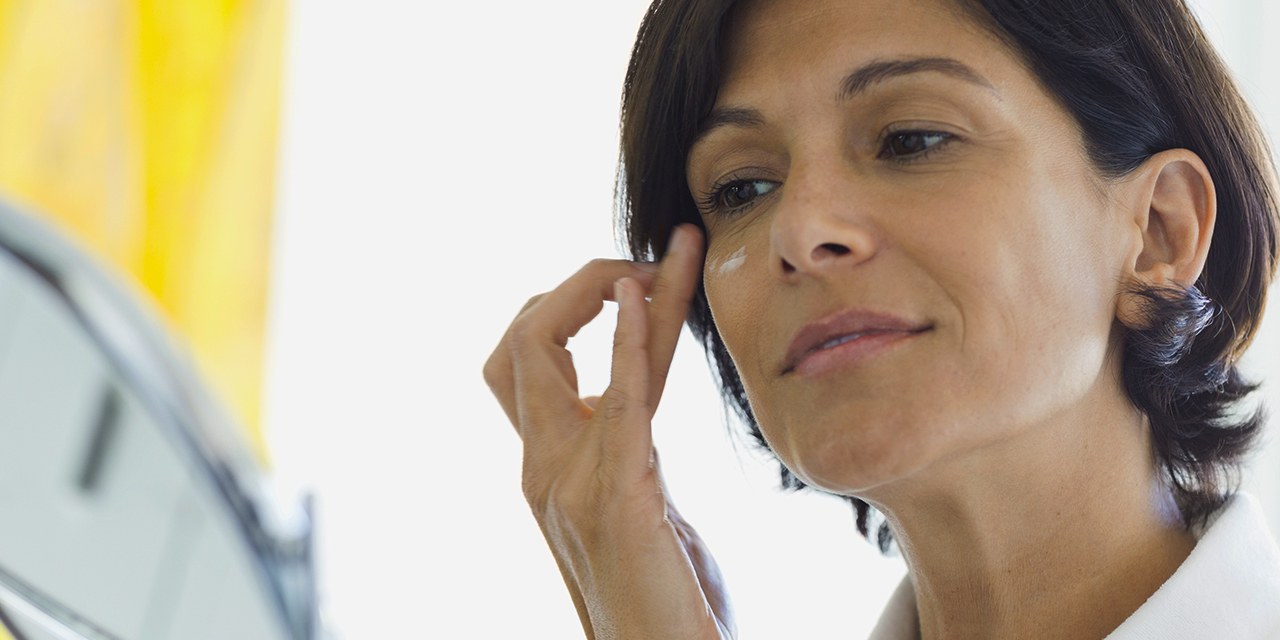
When you think about the way your skin changes as you age, there is the stuff you can’t do anything about, and the stuff you can. Chronological aging is the inevitable set of changes that happens to all of us as we clock birthdays. “As we go through the chronological aging process, four major things are happening to our skin: loss of collagen, loss of elastin, loss of fat and, finally, loss of bone,” Joyce Imahiyerobo-Ip, M.D., director of cosmetic dermatology at South Shore Medical Center, tells SELF. “Around age 35, our body naturally starts to break down collagen and elastin and new collagen and elastic production decreases, which results in loss of firmness of our skin, and the appearance of fine lines and wrinkles.”
The other type of aging, called intrinsic aging, is a bit more complicated and often self-induced. Intrinsic aging refers to the impact of environmental factors on our skin, such as daily exposure to the sun’s harmful UV rays (photo-aging), what we eat and drink, and other lifestyle habits that might negatively affect our skin, such as smoking. These external factors inhibit collagen production, resulting in more fine lines and wrinkles, and give rise to the appearance of sun spots, hyperpigmentation, and uneven skin tone and texture, explains Dr. Imahiyerobo-Ip. This premature skin aging isn’t 100 percent preventable or reversible, but you have the power to control its effects to some degree.
Now, you’d think that while your skin is getting, ahem, more mature, you’d at least get to stop worrying about the acne that plagued you as a teenager. Well, nope. Adult acne is real—it can even follow you into menopause.
The good news is that many ingredients that are used to treat signs of aging also treat acne. Including them in your skin-care routine can be a one-two punch against both.
Here are four dermatologist-recommended skin-care ingredients that are and shown to slow or reverse signs of aging, and treat or prevent acne.
1. Retinols/retinoids
This topical anti-wrinkle ingredient is basically deemed a straight-up miracle by most derms. Both over-the-counter retinols and prescription-only retinoids (which are stronger but also harsher) improve skin cell turnover, stimulate collagen, and help treat hyperpigmentation and acne. “Incorporating a retinol in your skin-care routine means fewer blackheads and whiteheads as well as fewer fine lines and wrinkles,” says Dr. Imahiyerobo-Ip. Her go-to retinoid is Differin Gel, $ 13, because it is both gentle and effective. “Previously, you could only get Differin with a prescription from your dermatologist, but now it’s available over the counter in the acne aisle,” she says. Her favorite retinol for skin that can handle a stronger product is Hydropeptide’s Nimni Cream, $ 110, a powerful anti-aging night cream than will also help mild acne caused by clogged pores.
2. Glycolic acid
This member of the alpha-hydroxy acid family is fruit-derived and ideal for all skin types—it’s even safe in pregnancy and while breastfeeding. “Glycolic acid has been shown to be effective for mild acne, likely due to its ability to help improve skin turnover and remove sticky, older skin cells,” Melanie D. Palm, M.D., San Diego–based dermatologist, cosmetic surgeon, and founding director of Art of Skin MD, tells SELF. “It also has a multitude of studies to back its effectiveness in anti-aging by improving skin tone and discoloration, skin texture, collagen stimulation, and overall glow/appearance to the skin.” Luckily, there are many, many glycolic acid-containing skin-care products to choose from, but Dr. Palm’s favorites include cosmeceutical lines such as Topix and Glytone, as well as Mario Badescu and Boots No7.
3. Salicylic acid
This beta-hydroxy acid is a classic acne-fighting ingredient. It’s what’s considered folliculotropic, meaning it is drawn to the hair follicle, which happens to be the starting location of zits. “Salicylic acid eliminates sticky cells in the hair follicle and oil gland ducts that can lead to acne and is also extremely effective in eliminating post-inflammatory hyperpigmentation from acne, especially in darker skin types,” says Dr. Palm. “For anti-aging, it helps improve skin tone and discoloration, and has some mild collagen-stimulating capacity.” You won’t have difficulty finding skin-care products containing salicylic acid. Dr. Palm’s go-tos include Glossier’s Solution Exfoliating Skin Perfector, $ 24, Neutrogena’s Acne Proofing Gel Cleanser, $ 10, and Proactiv+ Complexion Perfecting Hydrator, $ 50.
4. Azelaic acid
“Azelaic acid is a naturally occurring acid found in barley, rye, and grains that has potent antioxidant, antibacterial, and comedolytic properties,” which means it prevents clogged pores and pimples, explains Dr. Imahiyerobo-Ip. When it comes to preventing the signs of aging, azelaic acid has amazing skin brightening properties. Dr. Imahiyerobo-Ip often uses it in her practice for patients struggling with melasma (hormonal related facial hyperpigmentation) or excessive sun damage. “It works to brighten the abnormal skin, but has no negative effects on normal skin,” she says. “It’s also an antioxidant which means that helps prevent free-radical damage to the skin, which means less fine lines and wrinkles.” Although azelaic acid is usually only available via a prescription, it can also be found in both HydroPeptide’s Redefining Serum, $ 132, and The Ordinary Azeliac Acid Suspension, $ 8.
